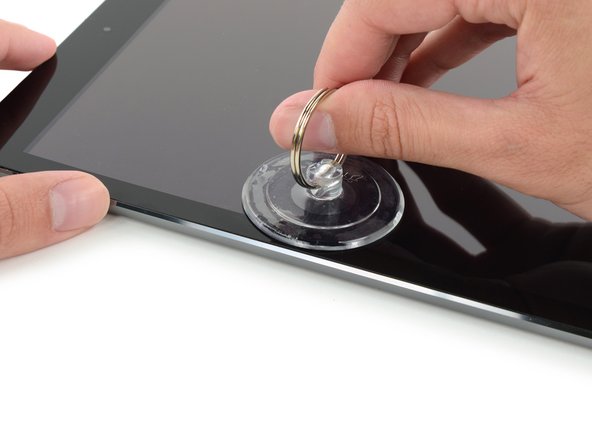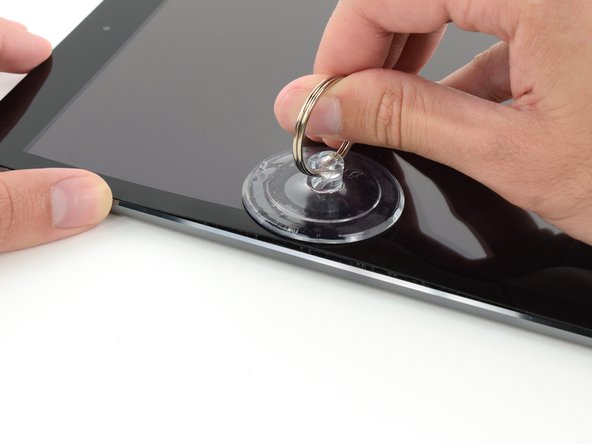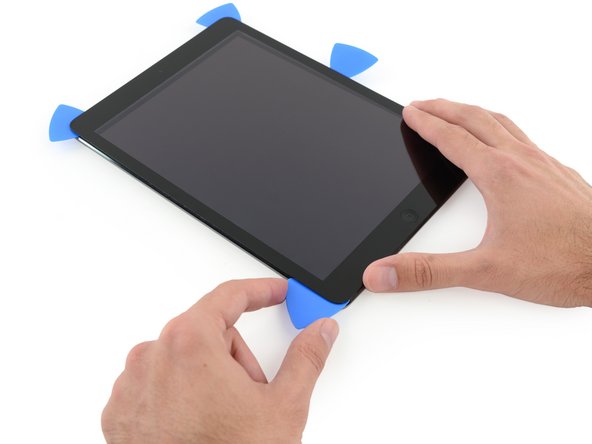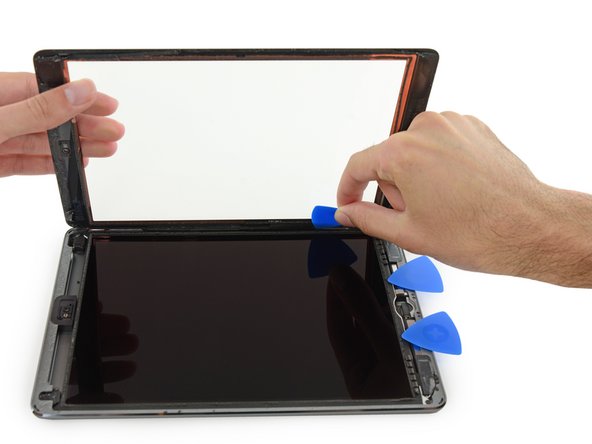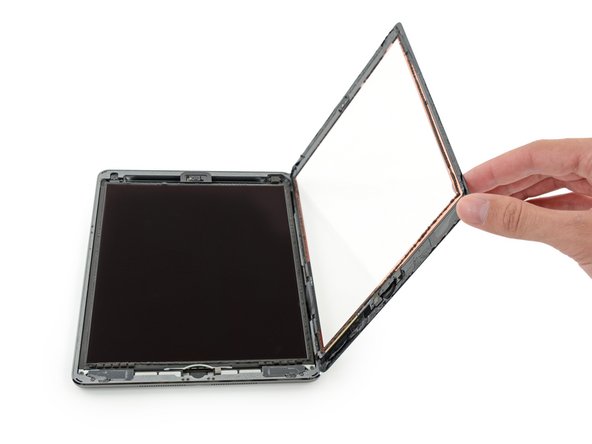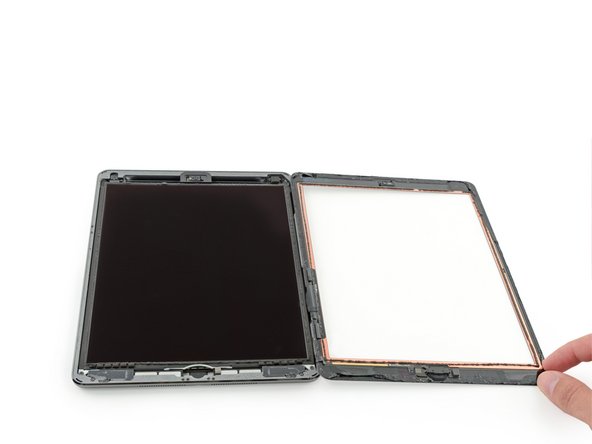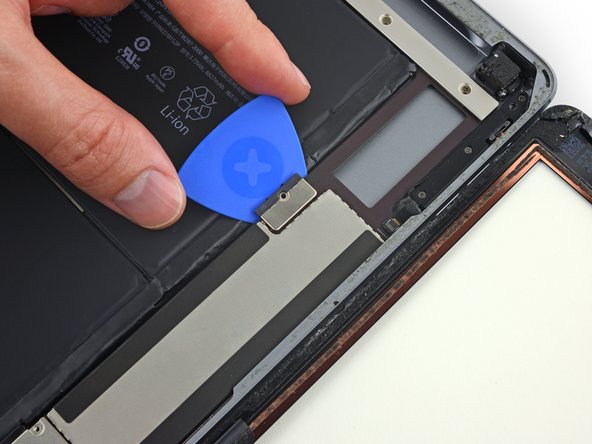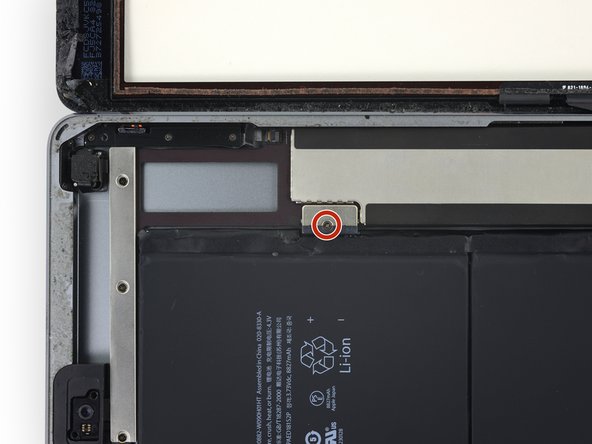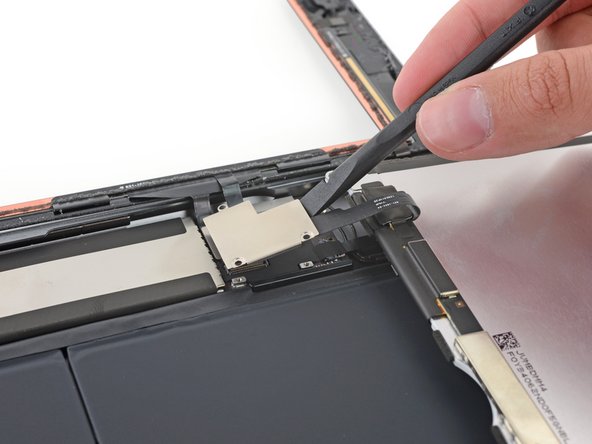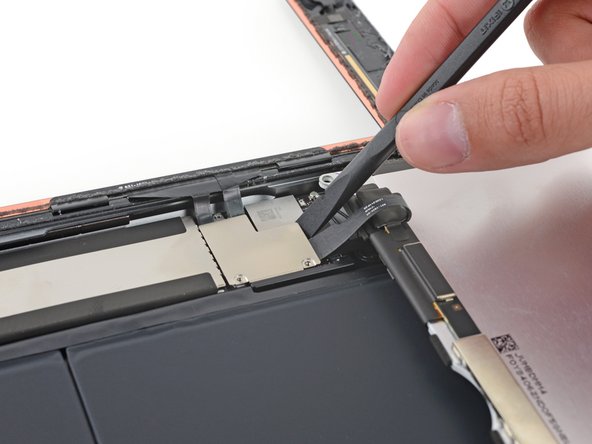iPad 6 Wi-Fi Front Facing Camera Replacement
Duration: 45 minutes
Steps: 80 Steps
Handle the battery blocker with care when isolating the battery. You don’t want to cause any accidental sparks or surprises!
Time to swap out the front-facing camera assembly, along with the ambient light sensor, for your iPad 6 Wi-Fi. When you're isolating the battery with a battery blocker, go easy—it’s easy to accidentally mess up the battery contacts, which can cause some serious issues with the logic board. If you skip isolating the battery, try not to use metal tools unless absolutely necessary (like for screws), as they could short the battery or mess with delicate circuits. Need a hand? No worries, you can always schedule a repair.
Step 1
- Grab your iOpener and heat it up! Apply it gently to the left edge of your device and let it work its magic for about two minutes. Patience is key here – give it time to soften things up before moving on to the next step.
Tools Used
Step 2
- While you're giving the adhesive a moment to relax, make sure you're aware of these sensitive spots that don't like a lot of prying around:
- Front camera
- Antennas
- Display cables
Step 3
The next three steps show off the Anti-Clamp, our handy tool that makes opening things up a breeze. If you're not using it, just hop ahead three steps for another way.
For the full scoop on using the Anti-Clamp, take a peek at this guide.
If the iPad's surface feels too slick for the Anti-Clamp to grip, slap on some tape to give it better traction.
- Grab the blue handle and pull it towards you to unlock the Anti-Clamp's arms. You're halfway there!
- Place something underneath your iPad to keep it steady and make sure it's sitting level between the suction cups.
- Place the suction cups on the left edge, one near the top and the other towards the bottom—like a perfectly balanced sandwich.
- Hold the bottom of the Anti-Clamp steady and press down firmly on the top suction cup. Apply some suction magic to get everything in place.
Step 4
- Gently pull the blue handle forward to lock those arms in place.
- Twist the handle a full 360 degrees (or until the suction cups start to stretch and you feel it click).
- Keep an eye on those suction cups—make sure they stay aligned. If they start to slip out of sync, just loosen them up a bit and get them back in line. Easy fix!
Step 5
Take it easy – no need to rush! Just turn it half a twist at a time, and give it a minute to settle before the next one. Let the Anti-Clamp and a little patience work their magic for you.
For detailed steps on wielding a hair dryer like a pro, peep this guide.
If the Anti-Clamp isn't opening up enough room, blast more heat on the spot and spin the handle clockwise by half a turn.
- Give the adhesive a minute to loosen up and create a nice gap for you.
- If your screen's not heating up enough, grab a hair dryer and warm up the left edge of the iPad.
- Once the Anti-Clamp opens up a good space, slide an opening pick under the digitizer.
- Skip the next step.
Step 6
If your display is really busted up with cracks, try slapping on some clear packing tape to help that suction cup stick. Or, swap in some heavy-duty tape for the suction cup. And hey, if nothing's working, a dab of superglue on the suction cup might just do the trick for that shattered screen.
- When the screen feels warm to the touch, grab your suction handle and attach it to the left edge of the screen, keeping it as close to the edge as possible.
- Use the suction handle to gently lift the screen and create a small gap between the digitizer and the frame.
- Slide an opening pick into that gap between the digitizer and the frame.
Tools Used
Step 7
No biggie if the opening pick shows through the digitizer—just slide it right out. The LCD screen should stay safe and sound, but you might end up with some pesky adhesive that's a pain to scrub off.
- Slip a second opening pick into that gap you just made. It's like opening a secret door!
- Gently slide the pick towards the bottom-left corner of the device to separate the adhesive. You're almost there!
- Leave the pick right in that bottom-left corner to stop the adhesive from sealing up again. Nice job, you're on track!
Step 8
- If your opening pick snags on the adhesive, just roll it along the iPad's side to keep loosening things up.
Step 9
- Gently slide the first opening pick towards the top-left corner of the device to break free from the adhesive.
- Leave the pick hanging out in the top-left corner to keep the adhesive from re-sealing.
Step 10
- Warm up your iOpener and gently apply it to the top edge of the device for two minutes.
Tools Used
Step 11
- Give the pick a gentle spin around the top-left corner to peel away that adhesive.
Step 12
Steer clear of sliding that pick over the front camera to avoid messing up the lens. The upcoming steps will guide you on dodging that pitfall.
- Gently slide the opening pick along the top edge of the device, stopping just shy of the front camera.
Step 13
- Gently tug the pick out so just the tip stays tucked between the screen and the frame.
- Slide that pick smoothly above the front camera to loosen up the adhesive.
- Leave the pick chilling near the right side of the front camera before you keep going.
Step 14
- Grab your pick and slide it up towards the top-right corner of your device to fully break the top adhesive seal. Nice and smooth!
- Keep that pick snug in the top-right corner to make sure the adhesive doesn’t decide to stick back together.
Step 15
- Grab an iOpener and give it a quick heat-up. Then, press it gently onto the right edge of your device for about two minutes to soften things up.
Tools Used
Step 16
- Gently guide your pick around the top-right corner of the device, carefully working through the adhesive to separate it.
Step 17
Hey, the display cables are hanging out about halfway up from the iPad's bottom. Slide until you're three inches from the base and you're good!
- Grab a fresh opening pick and shimmy it right to the center of the iPad's right side.
Step 18
- Warm up your iOpener and gently apply it to the bottom edge of the device for two minutes.
Tools Used
Step 19
Whoa, hold up—don't spin that pick all the way around the corner, or you might nick the antenna!
- Gently slide the bottom-left pick down to the corner to loosen that adhesive.
- Keep the pick tucked in the bottom-left corner before jumping to the next step.
Step 20
Slide the pick towards the home button, not away from it. You wouldn’t want to mess with the antenna, trust us!
If you need to go over this section again, just pop the pick out and reinsert it from the bottom-left corner. It's no big deal!
- Pop a fresh opening pick into the gap you just made on the bottom edge of the iPad.
- Slide that pick smoothly over the antenna, stopping right before the home button.
- Leave the pick hanging out to the left of the home button before you keep going.
Step 21
Be gentle and only insert the pick up about 1 mm in—any deeper and you might risk damaging the antenna. Keep it light!
- Slide an opening pick into the gap you've made. Nice and easy, just find that sweet spot.
- Gently push the pick underneath the home button and towards the bottom-right corner. Make sure only the tip is tucked between the digitizer and the frame—no need to force anything!
Step 22
Pro tip: Slide the pick towards the home button, not away from it, to keep the antenna safe and sound.
If you need to slide the pick back over this section, just pull it out and pop it back in at the bottom-right corner.
- Pop the pick back in and slide it towards the home button to fully break free the bottom adhesive.
- Leave the pick resting to the right of the home button and keep going from there.
Step 23
- Heat up your iOpener and stick it on the right edge of the device for two minutes.
Tools Used
Step 24
Take it chill with this one. Go slow, get that adhesive all warm and gooey, and make sure you've pried up every last bit with your pick. No sweat if you need to hit pause and reheat.
If you're feeling a bit of resistance, no worries—just give the edges a quick reheat and gently work your way around with an opening pick. Patience is key!
- Give those two opening picks a gentle twist at the left corners of the iPad to lift the digitizer just a bit, peeling off the remaining adhesive.
Step 25
- Gently lift the left side of the digitizer to help loosen the adhesive along the right edge of the iPad. Take your time, and remember, patience is key here!
Step 26
- Gently slide an opening pick between the two display cables while keeping the digitizer supported, to carefully separate the last bit of adhesive. Easy does it!
Step 27
- Once all the adhesive is peeled away, gently open the digitizer like you're flipping through a book and rest it parallel to the iPad.
- When putting everything back together, take a moment to clean off any leftover adhesive from the frame—and from the digitizer if you're reusing it—using a little isopropyl alcohol. You can replace the adhesive with our adhesive strips or pre-cut adhesive cards for a perfect fit.
- Watch out for the display cables as you reassemble the device. Make sure they’re neatly tucked under the LCD screen to avoid any unnecessary damage.
Step 28
- Pop the iOpener right in the center of your microwave like it's going on a mini vacation. Let it warm up for a bit, and you're good to go!
For carousel microwaves: Check that the plate moves smoothly. If the iOpener gets stuck, it could overheat and cause a burn-out. Keep it spinning to keep it winning!
It's a good idea to give your microwave a quick clean before diving in—any leftover crumbs or gunk at the bottom could end up sticking to the iOpener, and nobody wants that. Just a little cleanup now can save you time later!
Tools Used
Step 29
Keep an eye on the temperature of your iOpener during the repair! Overheating can cause it to burst, which is definitely not the goal. Try not to heat it beyond 100˚C (212˚F).
If the iOpener looks a bit puffed up, don't touch it. Seriously, no good can come from that.
If the iOpener is still too hot to handle in the middle, just keep using it and wait a bit for it to cool down before reheating. A well-heated iOpener should stay nice and warm for up to 10 minutes.
Heating time might differ based on your microwave's power level, so keep a close watch. The iOpener is good to go when it's just a bit too hot to comfortably touch.
- Kick things off by heating up the iOpener for 30 seconds.
- As you move through the repair steps, if the iOpener starts to cool off, just reheat it in the microwave for another 30 seconds whenever needed.
Tools Used
Step 30
Heads up! The iOpener gets pretty hot, so be cautious when handling it. A trusty oven mitt will do the trick if you need it!
- Carefully remove the iOpener from the microwave, making sure to grab one of the flat ends. This will help you avoid getting too close to the hot center.
Tools Used
Step 31
Hey, the iOpener's gonna be super hot, so play it safe and grip it just by those end tabs!
If you don't have a microwave, no sweat—just heat your iOpener in some boiling water to get it warmed up.
- Fill up a pot or pan with enough water to completely cover an iOpener.
- Bring the water to a rolling boil, then turn off the heat.
- Drop the iOpener into the hot water for about 2-3 minutes. Make sure it’s fully submerged, so it gets nice and toasty.
- Use tongs to carefully remove the iOpener from the hot water—watch out, it's going to be warm!
- Give the iOpener a good dry-off with a towel. No one likes a soggy iOpener.
- Now you’re ready to roll! If you need to heat it up again, just bring the water to a boil, turn off the heat, and let the iOpener soak for another 2-3 minutes.
Tools Used
Step 32
Gear up with safety glasses to shield those eyes, and take it easy on the LCD screen to keep it scratch-free.
This nifty step keeps those glass shards locked in and gives your display the solid support it needs while prying and lifting.
- Got a cracked display? No worries, just tape it up to avoid more mess and keep your fingers safe while working. A little prep goes a long way!
- Lay down some clear packing tape over the screen, overlapping the strips until the whole display is covered. This will help keep the glass in place as you work.
- Follow the rest of the guide as best as you can. But hey, if the glass starts cracking more, it's totally normal! You might need a metal prying tool to gently lift it out. Take your time and remember, if you need help, you can always schedule a repair.
Step 33
- Grab the iOpener by the tab and position it on the iPad's side, right next to the home button assembly.
- Give it a minute to hang out there and loosen up that adhesive under the glass.
Tools Used
Step 34
The iPad may look all sleek and solid on the outside, but there's a whole world of delicate parts under that front glass. To keep everything safe, make sure to only apply heat and pry in the areas we describe. It's all about keeping things smooth and avoiding any surprises!
- As you work your way through these steps, be extra mindful of these delicate spots:
- Front-facing camera
- Antennas
- Display cables
Step 35
Hey, the next three steps show off the Anti-Clamp, our clever tool that makes popping this thing open a breeze. If you're not using it, just skip ahead three steps for a different route.
For all the scoop on using the Anti-Clamp, check out this guide.
If the iPad's surface feels too slippery for the Anti-Clamp to grab, just add some tape for that extra grip.
- Give that blue handle a gentle pull backwards to unlock the Anti-Clamp's arms.
- Slide something under your iPad to keep it nice and level between the suction cups.
- Set the suction cups up near the middle of the left edge—one on top and one on the bottom.
- Keep the bottom of the Anti-Clamp steady, then press firmly on the top cup to get that suction going strong.
Step 36
- Slide the blue handle forward to lock those arms in place.
- Give the handle a full 360-degree clockwise spin, or keep turning until the suction cups start to stretch a bit.
- Keep an eye on the suction cups to make sure they stay lined up. If they start drifting apart, just loosen them a little and adjust the arms back into position.
Step 37
Don't go overboard with the turns—half a turn at a time is plenty. Take it slow and give it a minute between each turn. Let the Anti-Clamp do its thing while you relax and let time work its magic.
Need to get the most out of your hair dryer? Check out this guide for all the details!
If the Anti-Clamp isn't creating enough space, no worries! Just give the area a little more heat and twist the handle clockwise by half a turn.
- Hang tight for a minute—let that adhesive loosen up and create a nice gap.
- If the screen isn't warming up enough, grab a hair dryer and heat along the left edge of the iPad.
- When the Anti-Clamp opens a good gap, slip an opening pick under the screen.
- Skip the next two steps.
Step 38
If your iPad's screen is totally smashed, try smoothing it out with clear packing tape to help that suction cup stick better. Or, go for some sturdy duct tape folded into a grip-worthy handle for more pulling power!
- Stick that suction cup right in the middle of the warmed-up side for the best grip.
- Keep one hand pressing down on the iPad, then give the suction cup a gentle tug to create a tiny gap between the front glass and the back case.
- Make sure the cup sits flat against the screen to seal it up nice and tight.
Step 39
Don't push that opening pick deeper than the black bezel around the display. Going too far could risk messing up the LCD.
- Slide an opening pick into the little gap you made with the suction cup—think of it like sneaking a key into a locked door!
- Gently lift the suction cup's plastic nub to break the vacuum seal, then peel the suction cup away from the screen like a pro.
Step 40
Don't let the iOpener get too hot to handle! Give it at least ten minutes to cool down before reheating for the next round.
- Warm up the iOpener and swap it out for a fresh one.
Tools Used
Step 41
- Grab another opening pick and slide it right next to the first one, then glide it down the edge of the iPad, freeing up that stubborn adhesive along the way.
Step 42
- Gently slide the opening pick down the side of the display, letting it work its magic and free up that sticky adhesive.
- If the pick seems a little stuck in the gooey stuff, just give it a little roll along the edge of the iPad to help release more adhesive. Keep going—you've got this!
Step 43
- Grab that first pick you inserted and slide it up toward the top corner of the iPad.
- If you spot the tip of the opening pick through the front glass, no worries—just pull the pick out a little. Usually, it's all good, but let's avoid this to keep adhesive from sticking to the LCD—that stuff's a pain to clean off.
Step 44
Take it easy with the heat on the iOpener—no need to rush! Give it a solid 10 minutes to cool down before you reheat it. Your phone will thank you!
Got a flexible iOpener? Sweet! You can bend it to heat both the upper left corner and the upper edge at the same time. It’s a little multitasking magic for your device repair.
- Give that iOpener a quick reheat and stick it on the top edge of your iPad, right over the front-facing camera – nice and toasty!
Tools Used
Step 45
- Gently work the opening pick around the top left corner of your iPad to carefully loosen the adhesive. Take your time—this step doesn’t need to be rushed!
Step 46
Hey, steer clear of sliding that opening pick over the front-facing camera—you might smudge the lens or nick the camera. The next steps will show you the best way to keep that camera out of the mix.
The third image shows the location of the front-facing camera and its housing on the iPad.
- Gently slide your opening pick along the top edge of the iPad, stopping just before you hit the camera. You’ve got this!
Step 47
- Ease the pick out just a little, and smoothly glide the tip along the top of that front camera section on the top edge.
Step 48
- Keep your opening pick just a tad past the front-facing camera—think of it as giving your iPad a little nudge.
- Grab a second pick and slide it in to the left of the camera, then glide it toward the corner to finish slicing through that stubborn adhesive. Smooth moves!
Step 49
- Gently slide the previous pick a bit further into the iPad, then ease it away from the camera and toward the corner. Keep it steady and don’t rush—this part just needs a little finesse!
Step 50
- Keep those three picks snug in the corners of your iPad to stop the front panel adhesive from getting all clingy again.
- Pop the iOpener back in the heat and lay it down on the remaining side of your iPad—right along where the volume and lock buttons are chilling.
Tools Used
Step 51
Keep that pick right there to stop the adhesive from rebonding, and snag a fresh one for the next phase.
- Gently slide your opening pick around the top right corner of your iPad. This will free up the adhesive, making it easier to move forward with the repair.
Step 52
Heads up! The display cables chill out about halfway up from the bottom of your iPad. When your pick hits around 4.5 inches from the bottom, it's time to pause and check your progress.
- Pop a fresh opening pick in there and slide it along the middle of the right edge of the iPad, carefully peeling away that stubborn adhesive as you go.
Step 53
- Keep those opening picks where they are, and place the reheated iOpener on the home button side of the iPad to let the magic happen.
Tools Used
Step 54
The third image gives you a peek at the two antennas and the home button spot nestled in the lower part of the iPad case. It's like the iPad's secret hideout – just waiting for you to discover!
- Gently slide that lower left pick right into the corner to slice through the adhesive there.
- Keep the pick parked right at that corner—don't pry further or pull it out of the iPad, okay?
- The next moves will show you exactly where to pry to keep those components safe. Stick to heating and prying only where we say.
Step 55
Slide that pick nice and easy from the edge straight to the center of the iPad. Avoid sliding it back out, as that could mess up the antenna.
Keep that pick right where it is from the last step to stop the adhesive from sticking back together.
If you have to slide the pick over the bottom part more than once, take it out and pop it back in at the outer edge, then slide it back inwards.
- Grab a fresh pick and carefully slide it along the left antenna, making sure to stop just before you reach the home button.
- Keep that pick wedged in place before you move on to the next step.
Step 56
- Grab a fresh pick and slide it in just to the right of the last one.
- Gently glide over the home button and the right-hand antenna, using only the very tip to lift that adhesive.
Step 57
When handling the antenna, remember to slide it from the outer edge toward the center—kind of like making your way to the middle of the dance floor. Going the other way? Well, that could lead to some awkward moves and maybe even damage. Keep it smooth and steady!
- Adhesive loosened up? Cool, slide that pick in near the right corner. Glide it left across the screen, but chill just shy of the Home button.
Step 58
- Give that iOpener another quick heat-up and pop it back onto the volume control side of the iPad – keeping things nice and toasty!
Tools Used
Step 59
Hey, take it easy on this one. Go slow and make sure that adhesive is nice and warm, soft enough, and you've worked your way through all of it with the opening pick. No worries if you need to pause and heat it up again.
If the picks feel stubborn, don’t fight them—leave them in place, warm things up again with the iOpener, and gently try the tricky spots once more.
- Hey, on the opposite side from the volume buttons on your iPad, you've got picks tucked into each corner. Give 'em a gentle twist to lift the glass a bit, freeing up the last of that adhesive along the display cable edge.
Tools Used
Step 60
- Gently lift and ease the display cable away, making sure to detach the adhesive with a smooth, steady motion.
Step 61
Hey, take it easy on those display cables—we don't want any accidental nicks!
- While holding the front panel glass, gently slide an opening pick around to loosen the last bit of adhesive. Patience is key, take your time and avoid rushing!
Step 62
- After carefully loosening all the adhesive, gently swing the glass panel open like a book and let it rest on your workspace.
- When putting everything back together, wipe away any leftover adhesive from the case (and the front glass if you're planning to reuse it) using isopropyl alcohol. Then, swap in fresh adhesive by following our display adhesive application guide and using pre-cut adhesive strips.
- Watch out when reassembling—it's super easy to accidentally trap a flex cable between the front glass and the iPad’s frame. Be sure the flex cables fold softly and tuck neatly under the frame. If you press them completely flat, they might get damaged beyond repair.
Step 63
- Peel off any tape hiding the LCD screws.
Step 64
- Grab your Phillips #00 screwdriver and remove the four 4.3 mm screws holding that LCD in place. Once those are out, you're one step closer to getting everything back in action!
Step 65
Hey, don't try to fully pull out the LCD screen—it's still attached with a bunch of cables near the home button. Just lift it up from the camera end.
Take it easy and keep an eye on those LCD cables as you flip the display over.
Place the LCD gently on a soft, clean surface—something lint-free to keep things smooth and scratch-free. You want it comfy, like laying it on a cushion!
- Gently use the flat side of a spudger to lift the LCD just enough so you can get a good grip with your fingers. Be aware that there might be some glue around the screw holes that will need to be carefully sliced with a knife.
- Carefully flip the iPad LCD like you're turning a page in a book, starting near the camera and gently turning it over towards the home button side of the rear case.
- Place the LCD face down to give yourself easy access to the display cables.
Tools Used
Step 66
Hey, check out these snaps of the battery connector tucked under the logic board—they'll be your guide as you safely unplug that battery.
Spot those cantilever springs on the logic board? They're pressing against the battery's contact pads. With the board and battery glued in place, just slide something thin and flexible between the contact points to disconnect the battery.
Step 67
To avoid any accidental shorts, it's a good idea to use a battery isolation pick to disconnect the battery.
When sliding the battery blocker underneath the connector, be gentle—no need to force it. If it’s being stubborn, try using a playing card to help you out instead.
The battery blocker or playing card should smoothly slide under the logic board with no obstacles in the way. Once in, it should rest at a 15-degree angle.
- Carefully remove the 2.3 mm Phillips #000 screw holding the battery connector to the logic board.
- Slide the battery blocker under the logic board's battery connector at a 35-degree angle.
- Leave the battery blocker in place as you work.
Tools Used
Step 68
- Unscrew those three tiny 1.4 mm Phillips #000 screws holding down the display cable bracket. They're small, so take your time and be gentle, but you've got this!
Step 69
The display cable connector is stuck to the bottom of the bracket. So, be gentle when sliding your spudger underneath—too much force could mess with the connector. Take it slow and steady!
- Grab the flat end of your spudger and gently lift the display cable bracket straight up from the logic board.
Tools Used
Step 70
- Carefully remove the LCD screen.
Step 71
- Peel back any tape hiding the home button ribbon cable connector – let's clear the way!
Step 72
- Grab the flat end of your spudger and gently flip that tab on the home button ribbon cable's ZIF connector upward.
- Carefully pull the home button ribbon cable straight out of the ZIF connector.
Tools Used
Step 73
Hey, let's keep your iPad safe—pry only on the connectors, not the socket on the logic board, to avoid any oopsies!
- Grab the flat edge of a spudger or even your fingernail and gently pop those two digitizer cable connectors straight up from their sockets – take it nice and easy!
- When you're putting it all back together, make sure those connectors are fully seated, or you could run into some display glitches.
Tools Used
Step 74
- Gently lift the home button ribbon cable away from the adhesive that’s keeping it stuck to the back case. Take it easy and keep it smooth!
Step 75
Hey, this insulation is tricky—it's invisible to the naked eye and totally different from those foam dust barriers on a bunch of iPads.
- Carefully remove the front panel assembly.
- If you run into those pesky 'ghost' or 'phantom' touch issues on your shiny new display, just slap on a thin layer of insulating tape—like Kapton polyimide tape—to the marked spots on the back of the panel. Some premium panels already come with built-in insulation, so you might not need to add any extra tape.
- Without that insulation, the digitizer spots could short out against nearby components, messing up your touch sensitivity.
Step 76
- Unscrew the three 1.4 mm Phillips #000 screws holding down the upper component cable bracket. It’s like a little puzzle, just carefully remove those screws and set them aside.
Step 77
If you've got the Wi-Fi/Cellular version, your iPad might look a bit different. You’ll need to remove two extra screws to get to the components hidden behind this bracket. Take your time, and you’ve got this!
- Carefully detach the upper component cable bracket.
Step 78
Gently lift the connector, not the socket—treat it with care!
- Grab your spudger's flat end and give that front-facing camera connector a gentle disconnect from the logic board.
Tools Used
Step 79
Hey, depending on your digitizer removal method, this part might be stuck to the inside of the front panel.
- Gently use a spudger to lift the front-facing camera housing out of its case. Take your time, and don’t rush – the camera will thank you for the care.
Tools Used
Step 80
You'll find conductive tape connecting the front camera ribbon cable to the headphone jack cable right underneath. When you're swapping in a new front camera, press firmly on those gold contacts to get the cables reattached securely.
- Alright, let's button this up! Just retrace your steps in reverse order to get everything back together. If it feels tricky, you can always schedule a repair at Salvation Repair.




























































































